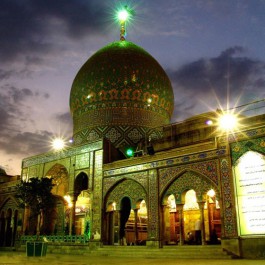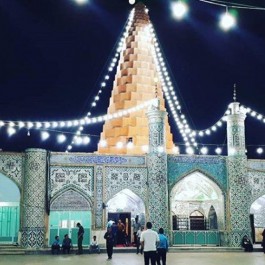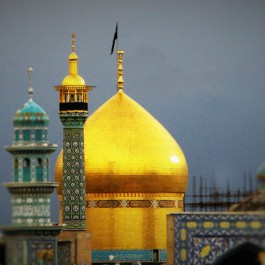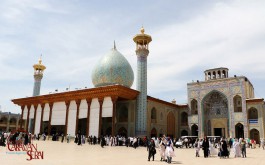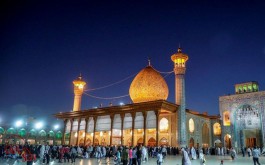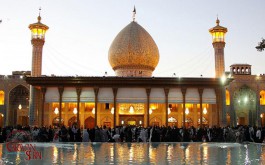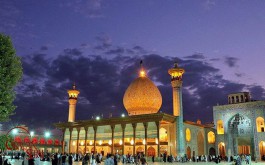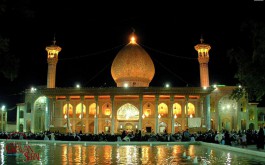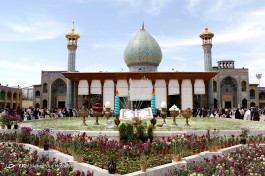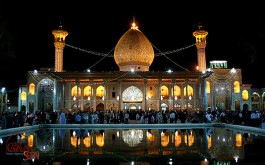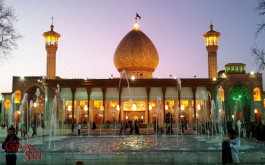History of the Shahragh shrine and tourist site
Shah Cheragh monument was built during Salghurids of Fars (Atabakan-e Fars) dynasty in the 6th century A.H. which is considered as one of the tourist attractions in Iran. The yard of Shah Cheragh has two main entrances in the south and north sides that pass through two giant tiled porches and connect to the vast yard of the shrine. Shah Cheragh's shrine is located in the west side of the yard and the shrine of Seyed Mir Muhammad (Shah Cheragh's brother) is situated in the north east of the yard.
Two-story rooms were built with tiled frontages around Shah Cheragh's yard. Iron columns of the porch of the shrine were covered by exquisite wood and also wood carving was used on its flat ceiling.
The queen Tashi Khatun, the mother of Shah Sheikh Abu Isaac Inju (the ruler of Fars) had taken benevolent measures for the shrine in 745 A.H. (1344 A.D.). This generous lady ordered to renovate Shah Cheragh shrine. A vast tomb with a dome on its top were built within five years between 745-750 A.H. (1344-1349 A.C.). Additionally, a large school was built adjacent to Shah Cheragh tomb. She had also donated many stores of the Bazaar which is located near Shah Cheragh and the property of Meymand Fars to this holy shrine.
Ibn Battuta, the Moroccan globetrotter who had travelled to Shiraz in 748 A.D. (1347 A.C.) for the second time, wrote about the Queen Tashi Khatun's measurements in his travelogue: "Shah Cheragh tomb is fully respected by the people of Shiraz and they visit Shah Cheragh for worship. Tashi Khatun, the mother of Shah Isaac, had invested in building a school next to the great monument where travelers can be feed. In addition, a number of Qaris (a qari is a person who recites Quran with proper rules of recitation) read Quran continuously around Shah Cheragh tomb. On Monday nights, Khatun comes to worship Shah Cheragh tomb, as well as the judges and jurists and Sadats (Sadat is an honorific title denoting people accepted as female descendants of the Islamic prophet and his close relatives) of Shiraz also attend there. The mentioned individuals gather in the shrine and read Quran with an ear- catching harmony. Food and fruits are distributed among people and the preacher goes up the pulpit and all these actions are done between afternoon and evening prayers".
Extensive refurbishment was carried out for Shah Cheragh tomb by the order of King Ismail Safavi in 912 A.H. (1506 A.C.). Due to an earthquake that was happen in 85 years later, in 997 A.H. (1588 A.C.) a half of the tomb's dome was destroyed which was rebuilt in the subsequent years. In 1142 A.H. (1729 A.C.) Nader Shah Afshar ordered to renovate Shah Cheragh Shrine extensively. Moreover, a massive chandelier had been hung from the ceiling of Shah Cheragh's dome by the order of Nader Shah. Nader Shah Afshar had promised if he conquers Shiraz, defeats Afghans and wins the war, he will rebuild the monument properly. Thus, after defeating Afghans and conquering Shiraz, 1500 Tomans, which was a spectacular amount of money, was spent on rebuilding Shah cheragh. The chandelier was 720 Mithqal (a unit of mass equals to 4.25 grams) in weight which was made of pure gold and a silver chain. The chandelier was still hung until 1239 A.H. (1823 A.C.). According to Anubanini research, in 1239 A.H. an earthquake hit Shiraz, destroyed the entire city, and Shah Cheragh Shrine had completely become derelict. The author of Tazkareh Delgosha, who witnessed the earthquake himself, discussed that: "The dome of Shah Cheragh Monument with its great height collapsed suddenly that seemed the earth is broken and the great shrine seemed like it was always derelict."
After the earthquake, the donated chandelier of Nader Shah was sold and the earned money was spent on renovating Shah Cheragh Shrine. In 1243 A.H. (1827 A.C.), Fath- Ali Shah Qajar appointed Hosein Ali Mirza Farman Farma to build the floor of the shrine one meter above the ground. The command was carried out and materials such as stone, brick and plaster were used instead of stone and Sarooj (a traditional water- resistant mortar used in Iranian architecture). In the end of construction, a silver Zarih (an ornate that encloses a grave in a mosque or Islamic shrines) had been installed on the grave. In 1269 A.H. (1852 A.C.), the dome of Shah Cheragh tomb was collapsed and broken due to an earthquake. In the same year, Muhammad Naser Zahir-al-doleh renovated the dome. Since then, many other changes have been made in Shah Cheragh Monument which have led to the current shape.
Small colored mirrors had used artistically in the interior of the shrine which is called Aina- Kari and a variety of beautiful Persian and Arabic calligraphies were decorated on the fringe of mirrors and tiles.
Profile of Shahchoragh building in Iran
The shrine's building consists of an Iwan (Persian: Eyvan is a rectangular hall or space, usually vaulted, walled on three sides, with one end entirely open) on the front and an extensive Haram (sanctuary or holy shrine) is situated at the rear of Iwan. There are four Shah Neshin spaces at the four sides of the Haram; in addition, a mosque had been built at the rear of the Haram (in the west side). Zarih of the shrine is situated in a Shah Neshin beneath the dome which was made of silver.
The yard of Shah Cheragh has two main entrances which are in the north and south sides of the Haram. After passing through two giant tiled porches you can enter the vast yard of the Haram. There is a large pool with a fountain in the center of the courtyard with many trees cultivated around the pool. Shah Cheragh's tomb is situated in the west side of the yard and the tomb of Seyed Mir Muhammad– the brother of Shah Cheragh – is in the north east side.
Except the two main entrances, there are two lateral doors that one of them enters Haji Bazaar and the other one leads to Jameh Mosque of Atigh. Moreover, a sub- door links the north side of the yard to Shah Cheragh Bazaar.
For the welfare of visitors, extensive facilities are located in the yard of the shrine including police station, post and telecommunication offices, library and museum.

